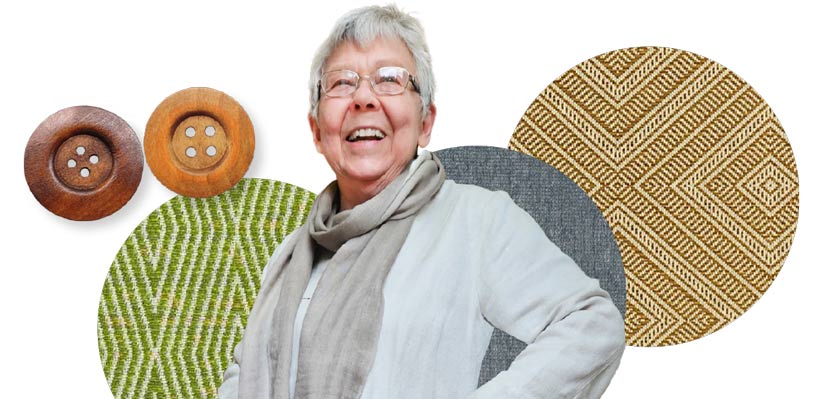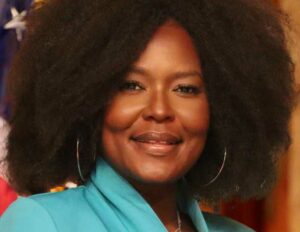
Sr. Judith Kubicki puts her best foot forward, wearing brands known for simplicity and made to last.
The recent youthful embrace of “slow fashion” reflects what Catholic Sisters have always done — shopping less often and more intentionally than most. Felician Sisters know how to “look good,” projecting their compassion and joy in all times and places. Just as importantly, they know how to “dress well,” approaching the simple task of getting dressed each day in solidarity with those on the margins, and considering issues of economics, human rights and climate policy. For Gen Z, thrifting “hauls” documented on TikTok or Instagram signify not just a youthful obsession with shaping identity through clothing, but a rebellion against “fast fashion” and a culture of unrestrained consumption. According to a recent news story, “Environmental sustainability has become a significant priority influencing the shopping choices of young consumers,” leading to the popularity of apps like Depop and thredUP for buying and selling clothes, and a host of DIY upcycling channels on YouTube, as young people search for budget-friendly and sustainable fashion. At Madonna University, in Livonia, MI students enrolled in Michelle Proctor’s Introduction to Community Leadership course organized a clothing swap on campus. Proctor asked her students to read about the impact of the clothing industry on the environment. Then, they worked with members of Madonna’s Laudato Si’ team to organize the event, discovering in the process that a clothing swap met a need close to home. Various campus constituents — students, staff and faculty — were among those who donated clothing and who benefited from the donations, clearly demonstrating a need that crosses demographic categories. “It was definitely reciprocal,” says Proctor. Elizabeth Prough, a political science professor at Madonna and member of the Laudato Si’ committee, explains that the benefits went beyond the original conceptions for the event, serving “a multiplicity of needs” — from a single mom who got a dress for the holiday to a student who found clothing for his family. Donors also benefited by cleaning their closets. Giving away garments, students gained a deeper awareness of patterns of consumption as well as community organization, and people from all walks of campus life came together for a fun event.
Some eco-friendly fashion tips
1. Choose natural fabrics and ethical brands.
Sr. Judith understands the array of justice issues related to what we wear, from the dyes used in the textile industry that contaminate our water, to the safety conditions of workers in garment factories. She points out that synthetic fabrics use petroleum — and the need to get away from fossil fuels in general. While she used to think that buying the cheapest garments was the best way to live in solidarity with those on the margins, she now takes time to shop for brands that use natural fabrics and dyes. She realizes that in a more thoughtful pattern of consumption,
“You may not buy the cheapest piece of clothing, but what you’re doing is honoring the environment, honoring the welfare of the people who produced it, honoring the earth.”
Like Sr. Judith, we can all read labels to find out where clothing is produced, and we can choose sustainable fabrics rather than synthetic ones.

2. Repair rather than replace.
Sr. Rosemarie Goins, in San Antonio, TX uses her sewing skills to show kindness to the planet. “I have some stuff I’m still wearing from the 70s and 80s,” she reports. In convents around North America, Felician Sisters take a sensible approach to wardrobe issues. “If we get too fat or too skinny or the elastic gives out, we just put a new band on our skirt,” Sr. Rosemarie says. “If a hem comes out, we fix it.” Rather than throwing away something that is stained or missing a button, repurpose or repair it.
3. Wear what you already own.
Sr. Judith Kubicki says that our clothing is one way that we identify with creation. “It’s a matter of being in touch with one’s surroundings, and one’s most immediate surrounding is what one is wearing,” she says. It might seem obvious, but rather than buying something new, familiarize yourself with the contents of your closet. Next time you are tempted to shop for new clothes, you might discover you already have what you need
4. Buy second-hand.
Sr. Mary Jean Sliwinski chooses to dress in solidarity with those on the margins, so she buys her clothes at Goodwill. Buying second-hand clothing stops it from going into a landfill and saves the energy and water that would go into making new clothing. These days, there are many different types of vintage stores, including online ones like Oxfam that use profits to fight poverty worldwide and benefit Fair Trade producers.
5. Buy less.
Through the 1970s or later, each convent had a vestry, with seamstresses who sewed all of the habits. Sr. Mary Rosita Brennan recalls that in Lodi, NJ, three sisters worked in the vestry to outfit 800 sisters in the convent. With bolts of wool fabric purchased wholesale, the sisters would sew “cruciform” dresses — long, cross-shaped garments worn with cinctures (rope belts) around the waist. These durable dresses suited any occasion, from work to church, lasted for years, and could be mended, altered and recycled. Each sister owned two or three, rotating a “Sunday” habit, a “school” habit and a “cleaning” habit. “Everything we owned could fit into a carry-on size suitcase,” Sr. Rosita remembers. While most people these days own more than two or three outfits, we all can imitate the sisters’ old-fashioned habits of simplicity by considering that we truly don’t “need” as much as we might think we do.
Whether shopping for ethical brands, thrifting, or sewing, many sisters and Gen Zers share similar techniques for dressing sustainably. When Sr. Mary Jessica Terek entered the convent, just before Vatican II, she remembers, “For me, the habit was a sign of my consecration, a life that I wanted to live.” Over the years, she has grown to realize, “Our habit shouldn’t speak for us. We should speak with our actions.” And one action taken by the sisters is focusing on justice issues in all they do, which leaves more time, money and energy for the things in life that really matter. “Ultimately, it’s not what you wear. It’s what you do,” Sr. Jean echoes. “We are all trying to follow Mother Angela and serve God as best we can.”




